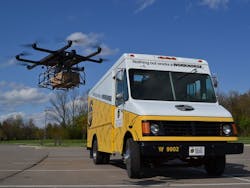Drone package delivery from trucks being tested
Over the past several years, e-commerce has transformed consumer behavior.
For the transportation industry, that has resulted in what is commonly referred to as the last mile distribution challenge. This is the moment the customer finally receives their order.
This home delivery model is typically the most expensive – representing more than 50 per cent of the total logistics, the least efficient and the most problematic part of the overall delivery process.
“The best mile is the one not driven,” says Stephen Burns, CEO, of Workhorse Group, a company that is testing package deliveries using drones, but not in the way you might think. Its drone, the HorseFly, delivers and returns from a delivery truck.
The HorseFly is an eight-rotor (octocopter) drone designed to be used in tandem with Workhorse’s electric work truck, he explained during a session on driving innovation in the advanced transportation industry at the recent 2016 Advanced Clean Transportation (ACT) Expo.
The drone, which weighs about 15 pounds empty, has a payload capacity of 10 pounds, can achieve a maximum speed of 50 mph and has a flight time of 30 minutes.
Workhorse is the parent company of electric truck manufacturer AMP Electric Vehicles.
Commercial use of drones is not allowed by the Federal Aviation Administration (FAA), but there are a few exception, one of which was obtained by Workhorse last year, said Burns.
The operation
The delivery driver places a package in the HorseFly. Then, using a touchscreen interface, he programs in a delivery destination.
The drone has the ability to launch itself from the roof of the delivery vehicle and, autonomously, ascend to a safe cruising altitude. It then navigates to the desired delivery point – for example, a house’s front stoop, using GPS navigation.
When the HorseFly reaches the GPS delivery destination, a human pilot in a remote location monitors the descent with a multi-camera video feed and executes the package drop off. The HorseFly then ascends back to a safe cruising altitude.
Burns noted that the delivery truck doesn’t wait for the drone to return. Instead, the driver moves on to his next delivery and the HorseFly catches up by navigating to the new location. It uses Infrared Tracking to land and dock with the truck.
The HorseFly then recharges its battery using the onboard battery of the electric vehicle.
A video of the HorseFly in operation can be found here.
